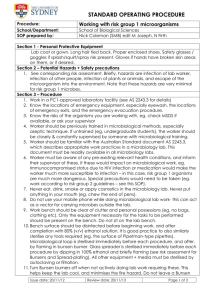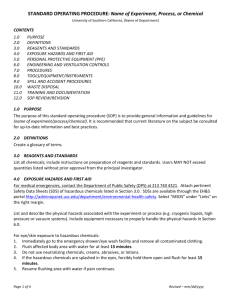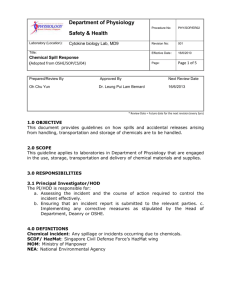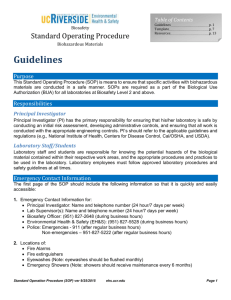Working with risk group 2 microorganisms
advertisement
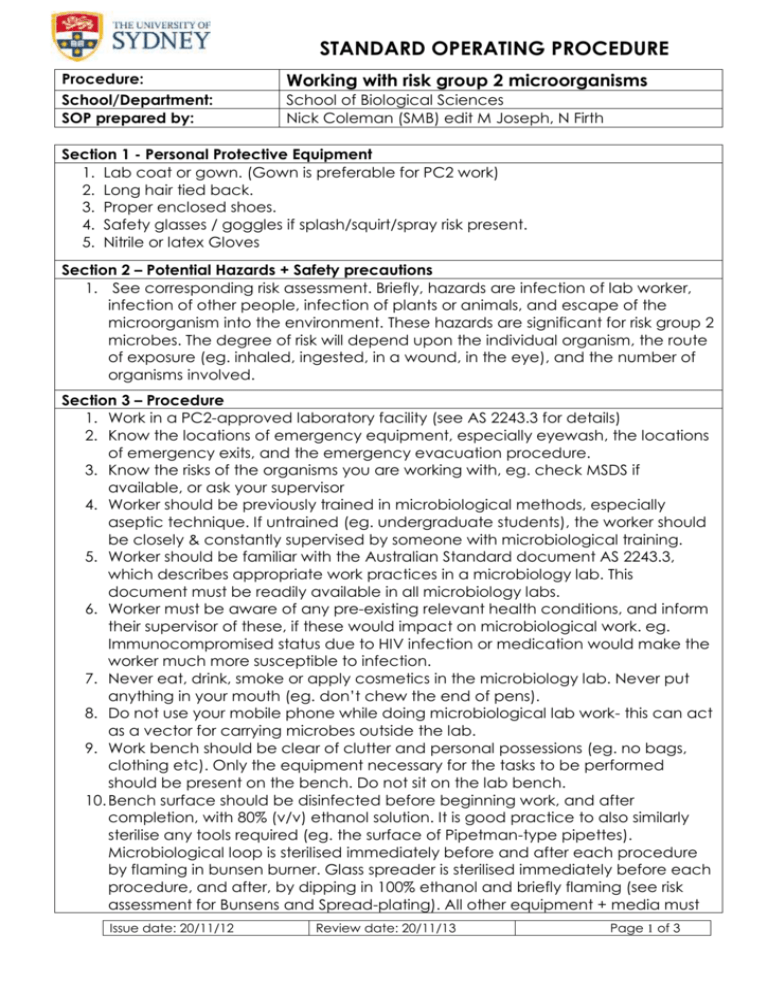
STANDARD OPERATING PROCEDURE Procedure: School/Department: SOP prepared by: Working with risk group 2 microorganisms School of Biological Sciences Nick Coleman (SMB) edit M Joseph, N Firth Section 1 - Personal Protective Equipment 1. Lab coat or gown. (Gown is preferable for PC2 work) 2. Long hair tied back. 3. Proper enclosed shoes. 4. Safety glasses / goggles if splash/squirt/spray risk present. 5. Nitrile or latex Gloves Section 2 – Potential Hazards + Safety precautions 1. See corresponding risk assessment. Briefly, hazards are infection of lab worker, infection of other people, infection of plants or animals, and escape of the microorganism into the environment. These hazards are significant for risk group 2 microbes. The degree of risk will depend upon the individual organism, the route of exposure (eg. inhaled, ingested, in a wound, in the eye), and the number of organisms involved. Section 3 – Procedure 1. Work in a PC2-approved laboratory facility (see AS 2243.3 for details) 2. Know the locations of emergency equipment, especially eyewash, the locations of emergency exits, and the emergency evacuation procedure. 3. Know the risks of the organisms you are working with, eg. check MSDS if available, or ask your supervisor 4. Worker should be previously trained in microbiological methods, especially aseptic technique. If untrained (eg. undergraduate students), the worker should be closely & constantly supervised by someone with microbiological training. 5. Worker should be familiar with the Australian Standard document AS 2243.3, which describes appropriate work practices in a microbiology lab. This document must be readily available in all microbiology labs. 6. Worker must be aware of any pre-existing relevant health conditions, and inform their supervisor of these, if these would impact on microbiological work. eg. Immunocompromised status due to HIV infection or medication would make the worker much more susceptible to infection. 7. Never eat, drink, smoke or apply cosmetics in the microbiology lab. Never put anything in your mouth (eg. don’t chew the end of pens). 8. Do not use your mobile phone while doing microbiological lab work- this can act as a vector for carrying microbes outside the lab. 9. Work bench should be clear of clutter and personal possessions (eg. no bags, clothing etc). Only the equipment necessary for the tasks to be performed should be present on the bench. Do not sit on the lab bench. 10. Bench surface should be disinfected before beginning work, and after completion, with 80% (v/v) ethanol solution. It is good practice to also similarly sterilise any tools required (eg. the surface of Pipetman-type pipettes). Microbiological loop is sterilised immediately before and after each procedure by flaming in bunsen burner. Glass spreader is sterilised immediately before each procedure, and after, by dipping in 100% ethanol and briefly flaming (see risk assessment for Bunsens and Spread-plating). All other equipment + media must Issue date: 20/11/12 Review date: 20/11/13 Page 1 of 3 be sterilised by autoclaving or filtration. 11. Turn Bunsen burners off when not actively doing lab work requiring these. This helps keep the lab cool, and minimises the fire hazard. Do not leave a Bunsen flame unattended, even for a few minutes. 12. When making transfers of cultures, streaking plates etc, work close to the Bunsen flame – this minimises deposition of airborne microbes onto/into media. 13. Work in a biosafety cabinet for any manipulations of risk group 2 organisms that are likely to generate aerosols – this includes vortexing, sonicating, pipetting, centrifugation, and opening tubes. See SOP for biosafety cabinet. Note that a laboratory gown (not coat) must be worn when using a biosafety cabinet. 14. All cultures must be labelled with the name of the organism (species and strain), the name or initials of the worker, and the date. Cultures must be incubated in the appropriate location, and must not be taken out of the lab. 15. Risk group 2 cultures must be transported inside a secondary unbreakable container if they need to be transported outside the PC2 lab. A strong plastic box with a lockable lid is ideal. See also SOP for Transport of GMOs. 16. Risk group 2 cultures must be stored in a secondary unbreakable container, and be properly labelled (as above), and records must be kept of the cultures. Also see SOP: storage of GMOs 17. Upon finishing work, sterilise the bench again, and discard all unwanted cultures into the appropriate location. All microbial cultures must be destroyed by autoclaving, they cannot be put down the sink, or in the regular garbage. See also the SOPs for Disposal of GMO contaminated waste and Disposal of Biological waste. 18. Wash your hands with antiseptic soap before leaving the laboratory, eg. with soap containing chlorhexidine. 19. Remove your lab coat or gown before leaving the laboratory. Lab coats or gowns used in PC2 labs must not leave the facility, unless they are autoclaved first. Autoclaving must be done before laundering the coat/gown. Section 4 – Spills / Incidents 1. Report all spills and other incidents to your supervisor, and if a serious incident occurs, this needs to be formally reported via the online reporting system. 2. In the case of a large spill of a risk group 2 organism (eg. >100 ml), allow 20 min for aerosols to settle before attempting to clean up the spill. Alternatively, wear a full-face respirator (found in spill kit) if you need to clean it immediately. 3. Contain the spill by surrounding with paper towel or an absorbent ‘boom’ from the spill kit, or other absorbent material 4. Disinfect the spill by adding freshly prepared bleach solution containing 1% hypochlorite. Allow at least 10 min for the bleach to kill the microbes. 5. Soak up all the liquids with paper towels, and dispose of all the towels and any other spill containment items used into a strong plastic bag (eg. a ‘wet garbag’ or a biohazard bag). 6. This bag containing the spill materials should NOT be autoclaved, as bleach will corrode the autoclave. Instead, this should be disposed of as medical waste, or as hazardous chemical waste. Section 7 - References 1. Australian Standard document AS 2243.3 2. Risk assessment and SOP: Disposal of biological waste 3. Risk assessment and SOP: Biosafety cabinet Issue date: 20/11/12 Review date: 20/11/13 Page 2 of 3 4. Risk assessment and SOP: Biohazard spills SOP Training Confirmation By signing below, these individuals confirm that they have read and understood the SOP, and agree to always follow the instructions in this SOP when performing this procedure. Position Name Signature Date Supervisor employee / student employee / student employee / student employee / student employee / student employee / student employee / student employee / student employee / student employee / student employee / student employee / student employee / student employee / student employee / student employee / student employee / student employee / student employee / student employee / student employee / student employee / student employee / student employee / student employee / student WHS Committee Approval Representative: A. Prof Frank Seebacher Chair Safety Committee Signature: ........................................................ Date: ..................................... Issue date: 20/11/12 Review date: 20/11/13 Page 3 of 3
